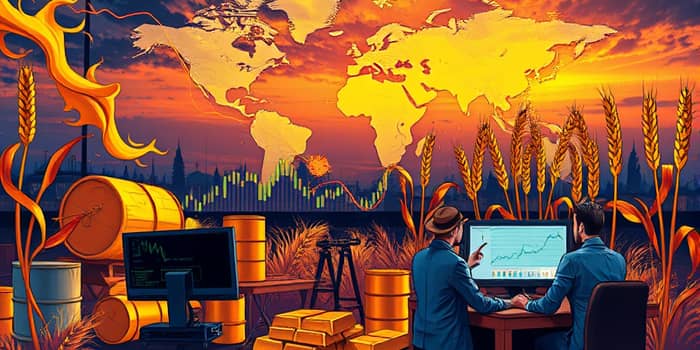The commodities market stands at a crossroads in 2025, shaped by a complex interplay of macroeconomic trends, geopolitical tensions, and rapidly evolving supply chains. For investors, corporations, and traders alike, understanding the forces at play is essential to navigate uncertainty, seize opportunities, and protect capital in an ever-shifting landscape.
The Macroeconomic and Geopolitical Landscape in 2025
As we enter 2025, the global economy contends with sticky inflation hovering near 3%, prompting central banks to balance growth with price stability. Meanwhile, the impact of a strong US dollar ripples across markets, driving up costs for non-US buyers and reshaping trade flows. Supply chains continue to strain under logistical challenges and environmental pressures, giving rise to recurrent supply and demand imbalances in key sectors.
Historically, 2022 marked a surge in commodity prices as the Bloomberg Commodity Index jumped 16% amid widespread inflation. In contrast, 2023 saw a 14% decline, followed by a modest 2% uptick in 2024. Looking ahead, analysts project an Aggregate Commodity Price Index drop of 1% in 2025, with 59% of major commodities set to trade lower than their 2024 averages.
Volatility and Its Core Drivers
Volatility remains the central challenge in commodities. Price swings can devastate budgets for commodity consumers—such as food manufacturers—and erode profit margins for producers. Three primary forces amplify this risk:
- Global economic growth deceleration and erratic demand patterns
- Geopolitical turbulence across the Middle East, Ukraine, and US-China relations
- Trade disruptions, sanctions, and extreme weather impacting supply chains
In addition, shifts in monetary policy and potential regulatory changes introduce further unpredictability. Investors must recognize that record highs in precious metals and energy price swings are not anomalies but symptoms of deeper systemic forces.
Strategies to Mitigate Risks
Protecting against dramatic price movements requires disciplined planning and execution. Market participants often deploy three cornerstone strategies:
- Hedging strategies through futures and options to lock in prices and cap potential losses
- Diversification through ETFs and commodity pools to spread exposure across multiple assets
- Partnering with experienced professionals to interpret market signals and identify arbitrage windows
By blending these approaches, investors can craft a diversified investment approach that cushions against sudden shocks while retaining upside potential when conditions improve.
Unearthing Opportunities Amid Uncertainty
While risks grab headlines, uncertainty also breeds opportunity. Commodities often exhibit low correlation with equities and bonds, making them a valuable addition to a balanced portfolio. Key avenues for gain include:
- inflation hedge for diversified portfolios as commodities historically outperform during price rises
- Arbitrage and speculation in futures markets for seasoned traders
- Sector-specific rallies in green minerals and energy transition metals
In particular, precious metals continue to attract safe-haven demand, while lithium, cobalt, and nickel benefit from the global shift toward renewable energy and electric vehicles.
Key Price Forecasts for 2025
Anchoring strategy in hard data, the following table outlines median price projections for major commodities in 2025:
These forecasts reflect lingering oversupply in energy markets, tightening fundamentals in agriculture, and sustained investor demand for precious metals.
Navigating the Market Structure
The commodities ecosystem encompasses both physical and derivatives markets. Spot trading facilitates immediate delivery of goods, while futures and options enable sophisticated hedging and speculative plays. Major sectors include energy (oil, gas, coal), metals (gold, copper, lithium), and agriculture (grains, softs like sugar and cocoa).
Market participants range from producers seeking stable revenues to institutional investors aiming for portfolio diversification. Hedge funds and proprietary traders often drive short-term volatility through high-frequency strategies, while corporate buyers lock in input costs via long-dated contracts.
Balancing Risks and Rewards: A Strategic Outlook
In 2025, commodities will continue to embody a dual nature: fraught with volatility yet ripe with opportunity. Success requires a blend of expert traders exploiting arbitrage opportunities and conservative hedging techniques to navigate sudden market shifts.
Above all, staying informed—through rigorous data analysis and keen awareness of geopolitical developments—is the foundation of smart decision-making. By balancing defensive tactics with calculated risk-taking, investors and firms can harness the full potential of commodities.
As markets evolve, those who embrace both caution and creativity will find themselves best positioned to turn uncertainty into advantage, ensuring that the journey through the commodities landscape yields lasting rewards.
References
- https://www.morganstanley.com/im/en-gb/intermediary-investor/insights/articles/commodity-outlook-2025-three-areas-to-watch.html
- https://www.spglobal.com/commodity-insights/en/news-research/topics/commodities-2025
- https://tradingeconomics.com/forecast/commodity
- https://www.euromonitor.com/article/commodity-market-outlook-q1-2025-heightened-uncertainty-amid-looming-policy-shifts-and-potential-tariffs
- https://internationalbanker.com/brokerage/commodities-are-likely-to-remain-under-pressure-in-2025/
- https://www.investopedia.com/terms/c/commodity-price-risk.asp
- https://www.investopedia.com/terms/c/commodity-market.asp
- https://brainworksinc.com/commodities-market-experienced-traders-2025/










